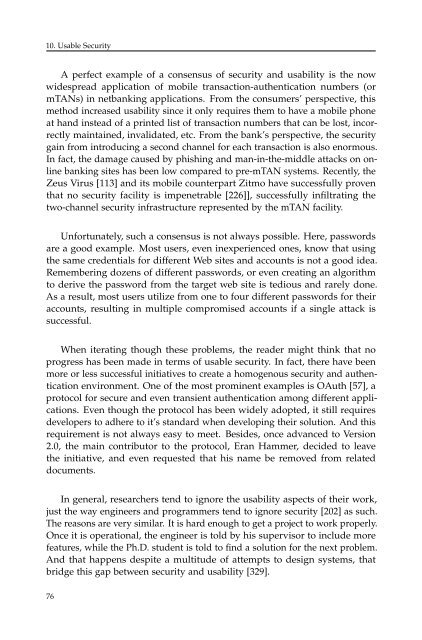syssec_red_book
syssec_red_book
syssec_red_book
Create successful ePaper yourself
Turn your PDF publications into a flip-book with our unique Google optimized e-Paper software.
10. Usable SecurityA perfect example of a consensus of security and usability is the nowwidespread application of mobile transaction-authentication numbers (ormTANs) in netbanking applications. From the consumers’ perspective, thismethod increased usability since it only requires them to have a mobile phoneat hand instead of a printed list of transaction numbers that can be lost, incorrectlymaintained, invalidated, etc. From the bank’s perspective, the securitygain from introducing a second channel for each transaction is also enormous.In fact, the damage caused by phishing and man-in-the-middle attacks on onlinebanking sites has been low compa<strong>red</strong> to pre-mTAN systems. Recently, theZeus Virus [113] and its mobile counterpart Zitmo have successfully proventhat no security facility is impenetrable [226]], successfully infiltrating thetwo-channel security infrastructure represented by the mTAN facility.Unfortunately, such a consensus is not always possible. Here, passwordsare a good example. Most users, even inexperienced ones, know that usingthe same c<strong>red</strong>entials for different Web sites and accounts is not a good idea.Remembering dozens of different passwords, or even creating an algorithmto derive the password from the target web site is tedious and rarely done.As a result, most users utilize from one to four different passwords for theiraccounts, resulting in multiple compromised accounts if a single attack issuccessful.When iterating though these problems, the reader might think that noprogress has been made in terms of usable security. In fact, there have beenmore or less successful initiatives to create a homogenous security and authenticationenvironment. One of the most prominent examples is OAuth [57], aprotocol for secure and even transient authentication among different applications.Even though the protocol has been widely adopted, it still requiresdevelopers to adhere to it’s standard when developing their solution. And thisrequirement is not always easy to meet. Besides, once advanced to Version2.0, the main contributor to the protocol, Eran Hammer, decided to leavethe initiative, and even requested that his name be removed from relateddocuments.In general, researchers tend to ignore the usability aspects of their work,just the way engineers and programmers tend to ignore security [202] as such.The reasons are very similar. It is hard enough to get a project to work properly.Once it is operational, the engineer is told by his supervisor to include morefeatures, while the Ph.D. student is told to find a solution for the next problem.And that happens despite a multitude of attempts to design systems, thatbridge this gap between security and usability [329].76


